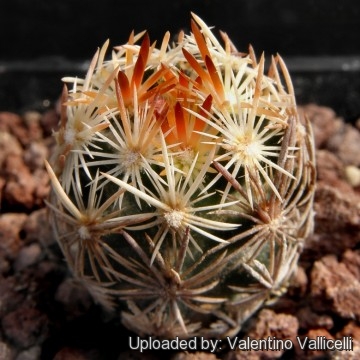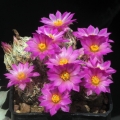Accepted Scientific Name: Escobaria minima (Baird) D.R.Hunt
Cact. Succ. J. Gr. Brit. 40(2): 30 (1978)

Coryphantha minima (Escobaria minima) Photo by: Valentino Vallicelli
SB423 Brewster Co, TX. This tiny cactus with its thick whitish spines and attractive pink flowers (larger than the plant itself), it is highly prized among collectors.
Origin and Habitat: Chihuahuan desert in the USA, they are found from only three populations, all in a tiny area of Brewster County, Texas.
Habitat: Grows in desert grassland, usually among the chips of weathered and physically fractured Caballos Novaculite rock (a quartz-like material). This species is now known only from three small sites
Synonyms:
Common Names include:
ENGLISH: Nellie Cory Cactus
Description: It is a tiny cactus with rounded, single stems up to 2,5cm tall and 6-17 mm wide, occasionally with a short tap root; tubercles 2 to 4 mm wide. A cultivated plant can be slightly larger, and clumped .
Spines: The plant is crowded with thick, corky, white spines (1 to 4 centrals, 4 to 6 mm long; 13 to 23 radials, 3.5 to 5 mm long)
Flowers: Numerous, pink, up to 2.5 cm in diameter, 1.5 cm long. The flowers are easy to pollinate, and produce around thirty seeds per fruit.
Blooming season: It blooms in several flushes, primarily in May, but the blooming period lasts from March until June.
Fruit: It produces ovoid, green fruit (1.5-5 cm long) that ripens from June to October.
Remarks: Escobaria minimaSN|9953]]SN|10308]] and Escobaria hesteriSN|10222]]SN|10222]] (From an adjacent hill) are two miniature plant which resemble dwarf races of Escobaria viviparaSN|10308]]SN|9953]], to wich they shares some characteristic, but much smaller in all parts. They can survive to –25°C in dry-winter regions.
Bibliography: Major references and further lectures
1) Flora of North America Editorial Committee. “Flora of North America, volume 4” Oxford University Press, New York. 2003.
2) Zimmerman, A.D. “Systematics of the genus Coryphantha (Cactaceae).” Dissertation, University of Texas, Austin. 1985
3)Castetter, E.F., P. Pierce and K.H. Schwerin. “A reassessment of the genus Escobaria” in: Cactus and Succulent Journal (U.S.) 47:60-70. 1975
4) Edward Anderson “The Cactus family” Timber Press, Incorporated, 2001
5) James Cullen, Sabina G. Knees, H. Suzanne Cubey "The European Garden Flora Flowering Plants: A Manual for the Identification of Plants Cultivated in Europe, Both Out-of-Doors and Under Glass" Cambridge University Press, 11/Aug/2011
6) David R Hunt; Nigel P Taylor; Graham Charles; International Cactaceae Systematics Group. "The New Cactus Lexicon" dh books, 2006
 - This is the smallest Escobaria, a real gem, and very beautiful!!! Plants flowering in cultivation do not self-pollinate, but are easy to hand pollinate, and produce around thirty seeds per fruit. (Escobaria minima) Photo by: Andrea B.
- This is the smallest Escobaria, a real gem, and very beautiful!!! Plants flowering in cultivation do not self-pollinate, but are easy to hand pollinate, and produce around thirty seeds per fruit. (Escobaria minima) Photo by: Andrea B. Coryphantha minima (Escobaria minima) Photo by: Valentino Vallicelli
Coryphantha minima (Escobaria minima) Photo by: Valentino Vallicelli Coryphantha minima (Escobaria minima) Photo by: Valentino Vallicelli
Coryphantha minima (Escobaria minima) Photo by: Valentino Vallicelli Coryphantha minima (Escobaria minima) Photo by: Peiffer Clement
Coryphantha minima (Escobaria minima) Photo by: Peiffer Clement Escobaria minima, seedling (Escobaria minima) Photo by: Carolina González
Escobaria minima, seedling (Escobaria minima) Photo by: Carolina González Coryphantha minima (Escobaria minima) Photo by: Cactus Art
Coryphantha minima (Escobaria minima) Photo by: Cactus Art Coryphantha minima (Escobaria minima) Photo by: Valentino Vallicelli
Coryphantha minima (Escobaria minima) Photo by: Valentino Vallicelli Coryphantha minima (Escobaria minima) Photo by: Valentino Vallicelli
Coryphantha minima (Escobaria minima) Photo by: Valentino VallicelliCultivation and Propagation: Very slow-growing, but easy to cultivate. Water regularly in summer, but do not over-water. It prefers a completely dry place during winter with much drainage. An unheated greenhoouse would be perfect. It can survive low temperatures (appr. -12 C). Full sun to light shade
Propagation: Easy to propagate from seed, cuttings and grafting.
Your Photos

by Valentino Vallicelli

by Valentino Vallicelli

by Cactus Art

by Andrea B.

by Valentino Vallicelli























